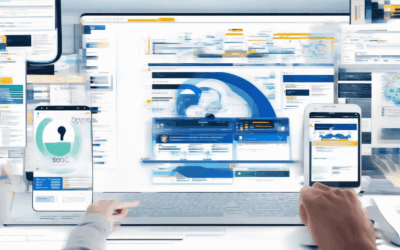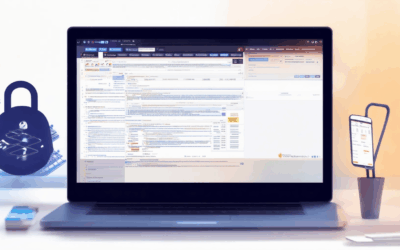In today’s interconnected world, our digital identity has become an integral part of who we are, reflecting our personal and professional lives. However, as our reliance on digital platforms grows, so do the risks to our online presence. From sensitive personal information to financial accounts, protecting our digital identity has never been more crucial. The potential consequences of neglecting this protection—such as identity theft, financial losses, and reputational damage—are severe and far-reaching. By taking proactive steps, we can secure our digital footprint, ensuring our personal and professional lives remain safe and intact. This guide explores essential strategies to safeguard your digital identity, helping you navigate the complexities of modern cybersecurity and maintain control over your online presence.
Key Takeaways
– Use Strong, Unique Passwords: Create complex passwords combining letters, numbers, and symbols, and avoid reuse across platforms.
– Enable Two-Factor Authentication: Add an extra security layer to protect your accounts from unauthorized access.
– Regularly Update Software and Devices: Keep your OS, apps, and devices updated to patch vulnerabilities.
– Be Cautious with Public Wi-Fi: Use a VPN to secure your connection and protect sensitive data.
– Limit Sharing Personal Information: Share details only with trusted parties to minimize exposure.
– Monitor Online Activity: Regularly check for suspicious logins or changes to your personal info.
– Backup Your Data Frequently: Securely store backups to prevent data loss in case of breaches.
– Use Privacy-Focused Browsers: Opt for browsers like BlindBrowser to enhance online privacy.
– Stay Informed About Cyber Threats: Keep up with the latest trends to protect yourself proactively.
– Consider Using a VPN: Enhance anonymity and security while browsing online.

How Can I Protect My Digital Identity?
To safeguard your digital identity, follow these essential steps:
- Use Strong Passwords : Create complex passwords with a mix of letters, numbers, and symbols. Consider using a password manager to keep track of them securely.
- Enable Two-Factor Authentication (2FA) : Add an extra layer of security to your accounts by enabling 2FA. This prevents unauthorized access even if someone knows your password.
- Regular Software Updates : Keep your devices and apps updated to patch vulnerabilities. Manufacturers regularly release updates to fix security flaws.
- Be Cautious on Public Wi-Fi : Avoid sensitive transactions on public networks. Use a VPN for added protection when connecting to unknown Wi-Fi.
- Adjust Privacy Settings : Regularly review and adjust your privacy settings on social media platforms and other online services to limit sharing of personal information.
- Encrypt Communication : Use encrypted messaging apps to protect your conversations from prying eyes.
- Monitor for Data Breaches : Check your email and credit reports periodically for signs of fraud or compromised accounts.
- Educate Yourself : Stay informed about the latest cybersecurity threats and learn how to avoid falling victim to scams.
By following these tips, you can better protect your digital identity and maintain your online security. Learn more about online privacy .
Is Protecting Your Digital Identity Worth It?
Protecting your digital identity is not just a precaution—it is essential for safeguarding your personal information and securing your online presence. Here’s why it is worth the effort:
1. Prevents Identity Theft
Protecting your digital identity helps prevent identity theft, where criminals steal your personal information to commit fraud. By safeguarding your data, you reduce the risk of having your identity used illegally.
2. Safeguards Sensitive Information
Your digital identity includes sensitive information like Social Security numbers, birthdates, and financial details. Protecting these ensures they are not accessed by unauthorized parties.
3. Avoids Financial Fraud
Protecting your identity helps prevent financial fraud, such as unauthorized transactions and withdrawals from your bank account. This peace of mind is invaluable.
4. Builds Trust with Service Providers
When you demonstrate that you take your digital identity protection seriously, service providers are more likely to trust you. This builds credibility and strengthens relationships with businesses you interact with online.
5. Complies with Legal Requirements
Many countries have strict data protection laws. Failing to protect your digital identity can result in legal consequences, including fines and penalties.
6. Preserves Your Online Reputation
In the event of a data breach, being recognized as someone who took precautions to protect your identity can help maintain your reputation. Others will see you as responsible and trustworthy.
Why BlindBrowser.com Stands Out
BlindBrowser.com offers comprehensive tools and resources to help you protect your digital identity. Our platform provides insights into the latest security trends, privacy tools, and laws affecting your online activity. We are committed to helping you maintain control over your digital footprint.
By taking the initiative to protect your digital identity, you are not just safeguarding yourself—you are ensuring your family, friends, and colleagues are also protected. The cost of inaction far outweighs the effort required to secure your identity. Start exploring BlindBrowser.com today to learn more about how we can assist you in staying safe online.

How to Protect Your Digital Identity
Protecting your digital identity is essential in today’s connected world. Here are proven strategies to safeguard your personal information and secure your online presence:
1. Use Strong, Unique Passwords
Create complex passwords with a mix of letters, numbers, and symbols. Consider using a password manager to store and organize your credentials securely.
2. Enable Two-Factor Authentication
Protect your accounts with two-step verification. This adds an extra layer of security beyond just your password.
3. Regularly Update Software and Devices
Keep your operating systems, apps, and devices updated to patch vulnerabilities that hackers could exploit.
4. Be Cautious with Public Wi-Fi
When connecting to public networks, use a VPN to encrypt your data and avoid potential eavesdroppers.
5. Limit Sharing Personal Information
Think before you click! Avoid sharing sensitive details like addresses or phone numbers online unless it’s necessary and the site is secure (https).
6. Monitor Your Online Activity
Regularly check your accounts for suspicious activity. Look out for unauthorized transactions or changes to your personal info.
7. Backup Your Data
Regularly back up important files to an external drive or cloud storage. This ensures you can recover lost data in case of a breach.
8. Educate Yourself About Cyber Threats
Stay informed about the latest threats and scams. Knowledge is your best defense against phishing, malware, and identity theft.
9. Use Privacy Tools
Consider tools like BlindBrowser’s privacy tools to mask your IP address and browse anonymously.
10. Keep an Eye on Your Social Media
Adjust your privacy settings on social media platforms to limit what information is shared publicly.
By following these steps, you can significantly reduce the risk of identity theft and protect your digital footprint. Stay vigilant and always trust your instincts when it comes to online security.

What Measures Can You Take to Protect Your Digital Identity?
To safeguard your digital identity, BlindBrowser.com recommends the following comprehensive measures:
-
Use Strong, Unique Passwords
Create complex passwords combining letters, numbers, and symbols. Avoid reusing passwords across multiple platforms. Consider using a password manager to store and organize them securely.
-
Enable Two-Factor Authentication
Protect your accounts with 2FA, adding an extra layer of security beyond your password. This significantly reduces unauthorized access risks.
-
Regularly Update Software and Devices
Keep your operating systems, apps, and devices updated to patch vulnerabilities that hackers might exploit.
-
Be Cautious With Public Wi-Fi
Avoid sensitive transactions on unsecured networks. Use a VPN for added protection when connecting to public Wi-Fi.
-
Monitor Your Online Activity
Regularly check your accounts for suspicious activity, such as unrecognized logins or changes to your personal information.
-
Limit Sharing Personal Information
Provide personal details only to trusted parties. Be cautious about sharing information via unverified channels.
-
Backup Your Data Frequently
Regularly backup important files to an external drive or cloud storage to prevent data loss in case of breaches.
-
Use Privacy-Focused Browsers
Opt for browsers like BlindBrowser.com that prioritize privacy, offering features like tracking prevention and ad blocking.
-
Stay Informed About Cyber Threats
Keep up with the latest cybersecurity news and trends to better protect yourself against emerging threats.
-
Consider Using a VPN
A Virtual Private Network (VPN) adds an extra layer of anonymity and security when browsing online.
By implementing these measures, you can significantly enhance your digital security and protect your identity online. For further resources and tools, visit BlindBrowser.com .
Effective Ways to Protect Your Digital Identity
Protecting your digital identity is crucial in today’s increasingly connected world. Here are some proven strategies to safeguard your personal information:
1. Use Strong, Unique Passwords
Creating complex passwords with a mix of letters, numbers, and symbols is essential. Avoid reusing passwords across multiple accounts, and consider using a password manager to keep track of them securely.
2. Enable Two-Factor Authentication (2FA)
Two-factor authentication adds an extra layer of security beyond your password. Enable 2FA for your email, social media accounts, and financial institutions to protect against unauthorized access.
3. Regularly Update Software and Devices
Keeping your software and devices updated ensures you’re protected against the latest security threats. Enable automatic updates whenever possible to stay ahead of vulnerabilities.
4. Be Cautious with Public Wi-Fi
Public Wi-Fi networks can be risky, so always use a VPN when connecting to unknown networks. This encrypts your data and prevents potential eavesdropping.
5. Limit Sharing Personal Information
Think before you share personal details like your address, phone number, or birthdate. Only provide this information on trusted, official websites, such as those ending in.gov or.edu.
6. Monitor Your Online Presence
Regularly check your social media profiles and online accounts for suspicious activity. Set your privacy settings high to limit who can see your information and engage cautiously with unknown contacts.
7. Backup Your Data
Regular backups of your important files and data are critical. Store backups in a safe, offline location or use cloud storage with strong encryption.
8. Educate Yourself About Cyber Threats
Stay informed about common cyber threats and scams. Keep an eye out for phishing attempts and learn how to recognize suspicious emails, messages, or websites.
9. Use Encrypted Communication Tools
Encrypt your communications using tools like Signal or WhatsApp to ensure your messages remain private. Avoid using public chat apps for sensitive discussions.
10. Report Fraudulent Activity
If you suspect your identity has been compromised, report it immediately to the appropriate authorities. Monitoring your credit reports and financial statements can also help identify potential issues early.
By following these tips, you can significantly enhance your digital security and protect your identity online. Remember, staying vigilant and proactive is key to safeguarding your personal information in an increasingly interconnected world.

How to Protect Your Digital Identity
Protecting your digital identity is crucial in today’s increasingly connected world. Below are the key steps to safeguard yourself against potential threats:
- Use Strong Passwords:** Create complex passwords that combine letters, numbers, and symbols. Avoid reusing passwords across multiple accounts.
- Enable Two-Factor Authentication (2FA):** Add an extra layer of security to your accounts by enabling 2FA, often via SMS or authenticator apps.
- Regular Software Updates:** Keep your operating systems, browsers, and apps updated to patch vulnerabilities that hackers might exploit.
- Avoid Sharing Personal Information:** Refrain from posting sensitive details like birthdates, addresses, or phone numbers online.
- Stay Informed About Cyber Threats:** Regularly monitor your accounts and follow cybersecurity news to stay ahead of potential risks.
To further enhance your digital security, consider using tools like BlindBrowser , which offers comprehensive guides and tools tailored for online privacy and security. Additionally, explore resources from other trusted platforms such as NordVPN and LastPass for managing passwords and encrypting your data effectively.
Conclusion: By following these steps and utilizing reliable security tools, you can significantly reduce the risk of identity theft and unauthorized access to your personal information. Stay proactive and adapt to evolving cyber threats to maintain your digital safety.




